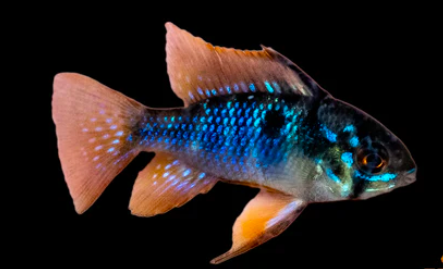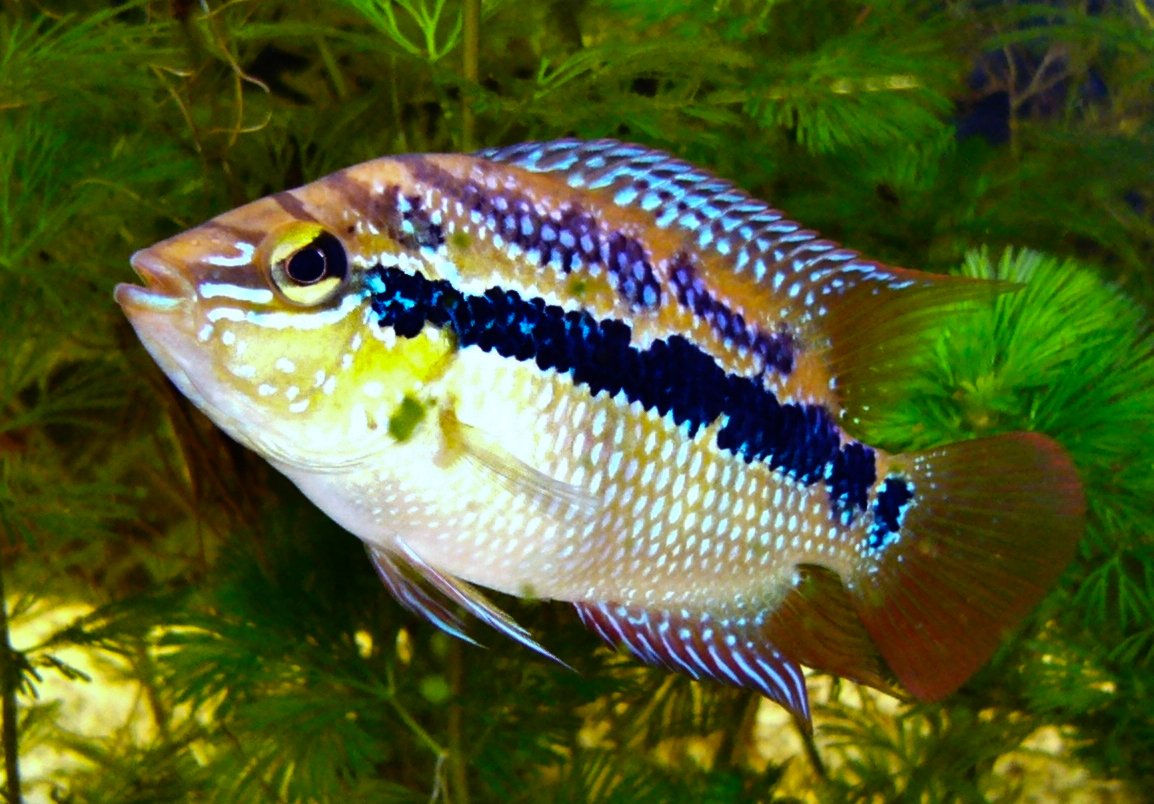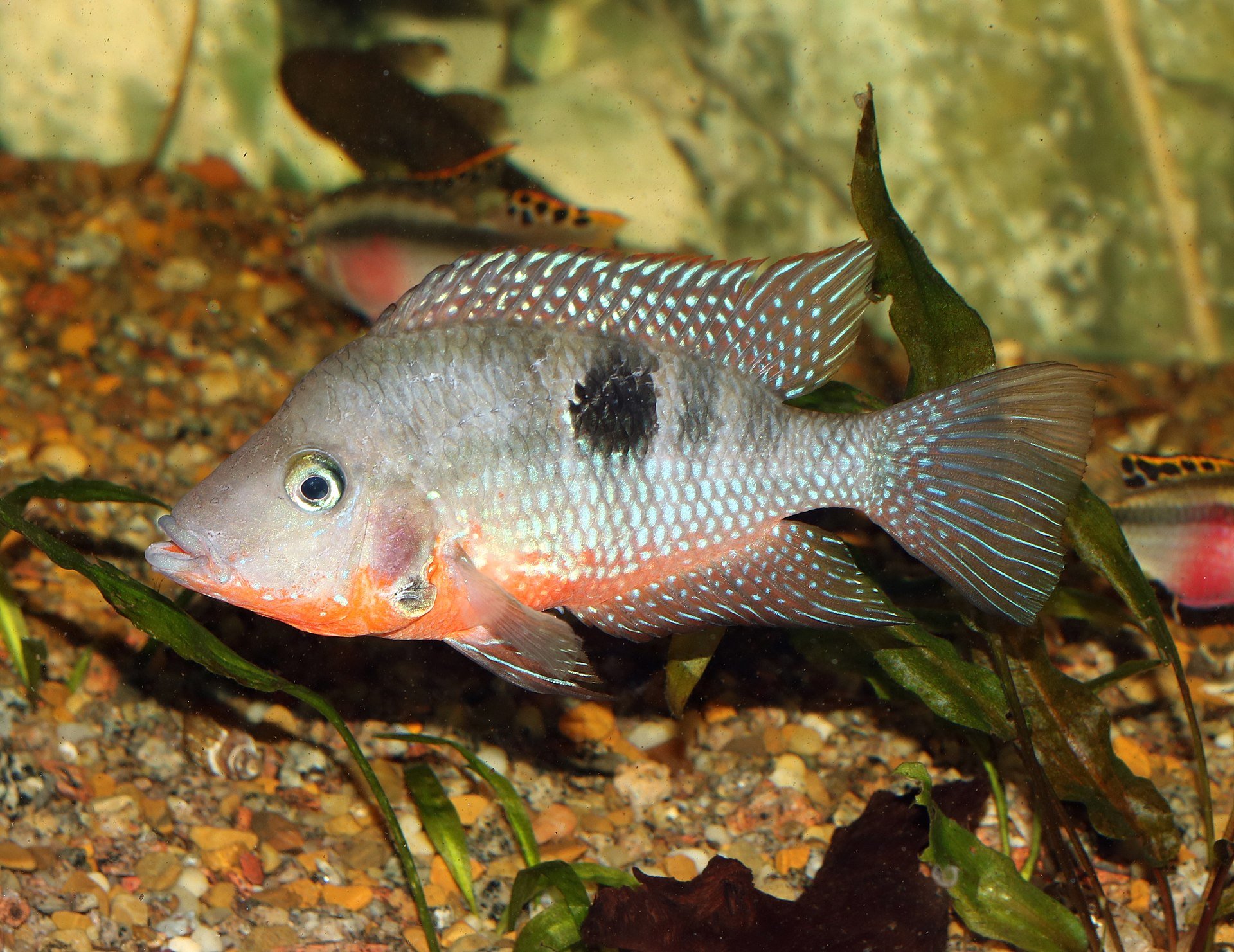 Image 1 of 1
Image 1 of 1


Cichlid- German Black Ram
German Black Rams (a variant of the German Blue Ram or Mikrogeophagus ramirezi) are known for their striking coloration and peaceful temperament. They require specific care to thrive in a home aquarium. Here's an overview of their care requirements:
1. Tank Size
Minimum Tank Size: 20 gallons (75 liters) for a pair
Tank Shape: Longer tanks are preferred to give them room to swim
2. Water Parameters
Temperature: 78-85°F (25-29°C) – prefer warmer waters
pH: 5.5-7.0 (slightly acidic)
Water Hardness: 3-8 dGH (soft water)
Ammonia/Nitrites: 0 ppm
Nitrates: Low levels (<20 ppm)
These fish are sensitive to poor water quality, so pristine water conditions are essential.
3. Filtration & Oxygenation
Use gentle filtration to avoid strong currents as rams prefer calm water.
Maintain good oxygenation, but avoid high flow rates as they like slower water.
4. Substrate and Décor
Substrate: Fine sand or soft substrate is ideal, as they like to sift through it.
Décor: Include driftwood, rocks, and plenty of plants (such as Anubias, Java Ferns) to provide hiding spots and a sense of security.
Lighting: Moderate lighting to mimic their natural environment.
5. Diet
Primary Diet: High-quality flake or pellet food specifically for cichlids.
Supplementary Food: Frozen or live food such as bloodworms, brine shrimp, and daphnia.
Frequency: Feed 2-3 times per day in small amounts to avoid overfeeding.
6. Tankmates
Compatible Tankmates: Peaceful fish like tetras, rasboras, corydoras, and small plecos. Avoid aggressive or larger fish that may stress the rams.
Behavior: Black Rams are territorial, especially during breeding, so keep pairs or a small group in a larger tank to reduce aggression.
7. Breeding
They are relatively challenging to breed and require specific conditions:
Spawning: Breeding pairs require flat surfaces like rocks for laying eggs.
Water Conditions: Soft, acidic water and temperatures around 82-84°F (28-29°C) encourage spawning.
Parental Care: Rams are attentive parents, guarding their eggs and fry.
8. Health and Lifespan
Lifespan: 2-4 years with good care.
Disease Sensitivity: They are sensitive to stress and poor water quality, which can lead to diseases like ich, bacterial infections, or swim bladder issues. Regular tank maintenance and stable water conditions are essential.
In summary, German Black Rams require a stable, well-maintained tank with soft, slightly acidic water, a varied diet, and peaceful tankmates. They are sensitive to changes, so keeping their environment stable is key to their health and longevity.
German Black Rams (a variant of the German Blue Ram or Mikrogeophagus ramirezi) are known for their striking coloration and peaceful temperament. They require specific care to thrive in a home aquarium. Here's an overview of their care requirements:
1. Tank Size
Minimum Tank Size: 20 gallons (75 liters) for a pair
Tank Shape: Longer tanks are preferred to give them room to swim
2. Water Parameters
Temperature: 78-85°F (25-29°C) – prefer warmer waters
pH: 5.5-7.0 (slightly acidic)
Water Hardness: 3-8 dGH (soft water)
Ammonia/Nitrites: 0 ppm
Nitrates: Low levels (<20 ppm)
These fish are sensitive to poor water quality, so pristine water conditions are essential.
3. Filtration & Oxygenation
Use gentle filtration to avoid strong currents as rams prefer calm water.
Maintain good oxygenation, but avoid high flow rates as they like slower water.
4. Substrate and Décor
Substrate: Fine sand or soft substrate is ideal, as they like to sift through it.
Décor: Include driftwood, rocks, and plenty of plants (such as Anubias, Java Ferns) to provide hiding spots and a sense of security.
Lighting: Moderate lighting to mimic their natural environment.
5. Diet
Primary Diet: High-quality flake or pellet food specifically for cichlids.
Supplementary Food: Frozen or live food such as bloodworms, brine shrimp, and daphnia.
Frequency: Feed 2-3 times per day in small amounts to avoid overfeeding.
6. Tankmates
Compatible Tankmates: Peaceful fish like tetras, rasboras, corydoras, and small plecos. Avoid aggressive or larger fish that may stress the rams.
Behavior: Black Rams are territorial, especially during breeding, so keep pairs or a small group in a larger tank to reduce aggression.
7. Breeding
They are relatively challenging to breed and require specific conditions:
Spawning: Breeding pairs require flat surfaces like rocks for laying eggs.
Water Conditions: Soft, acidic water and temperatures around 82-84°F (28-29°C) encourage spawning.
Parental Care: Rams are attentive parents, guarding their eggs and fry.
8. Health and Lifespan
Lifespan: 2-4 years with good care.
Disease Sensitivity: They are sensitive to stress and poor water quality, which can lead to diseases like ich, bacterial infections, or swim bladder issues. Regular tank maintenance and stable water conditions are essential.
In summary, German Black Rams require a stable, well-maintained tank with soft, slightly acidic water, a varied diet, and peaceful tankmates. They are sensitive to changes, so keeping their environment stable is key to their health and longevity.






